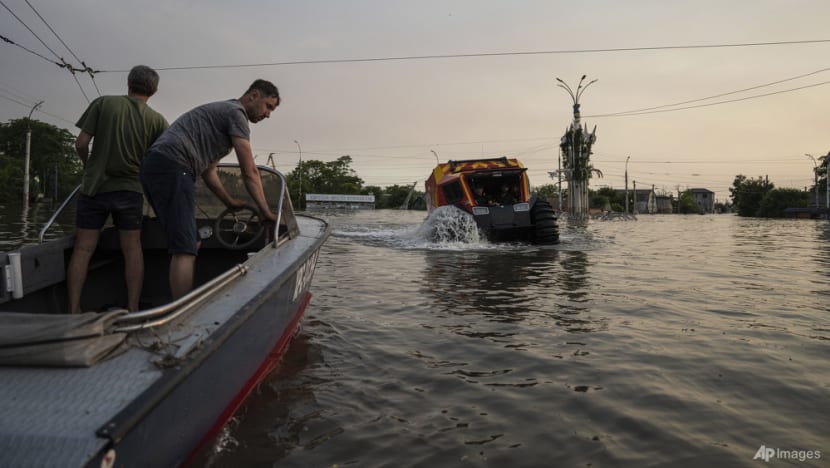Kakhovka dam collapse: Analysts weigh in on who has more at stake amid Russia and Ukraine blame game
While Kyiv itself has not confirmed that it has launched the much-awaited spring counter-offensive against Russia, one analyst said that “by the sounds of it, it has”.

Rescue workers evacuate people by a swamp walker vehicle in a flooded neighborhood of Kherson, Ukraine, Wednesday, June 7, 2023. Floodwaters from a collapsed dam kept rising in southern Ukraine on Wednesday, forcing hundreds of people to flee their homes in a major emergency operation that brought a dramatic new dimension to the war with Russia, now in its 16th month. (AP Photo/Evgeniy Maloletka)
Russia has more reason to have caused the collapse of a huge Soviet-era dam on the Dnipro River separating Russian and Ukrainian forces in southern Ukraine, analysts said on Wednesday (Jun 7), a day after the incident.
With the two countries blaming each other for the collapse of the Kakhovka dam, its destruction plays into the hands of the Russians, said Dr Alexey Muraviev, associate professor of national security and strategic studies at Curtin University.
He noted that the Russians initially claimed the dam was critically damaged as a result of shelling from the Ukrainian side, but Russian sources later confirmed there was no shelling on the night of the incident.
“There was some sort of internal explosion and since the dam was controlled by the Russian military, you can kind of draw some sort of conclusion,” he told CNA938’s Asia First.
Related:
He added the rising levels of the Dnipro river are an advantage for the Russians as it may hinder a possible amphibious assault by the Ukrainians.
“The Russians are actually improving the defensive layout as a result of this breach,” he said.
RUSSIANS “MISMANAGED” DAM
Mr William Courtney, adjunct senior fellow at United States think tank RAND Corporation, similarly said that the Russians were trying to impede crossing of the Dnipro river by Ukrainian forces.
“It would complicate, to some extent, any Ukrainian counter-offensive efforts that would require crossing the Dnipro river below the dam,” he told CNA’s Asia First.
“The Ukrainians have no reason to have blown up the dam,” he added, pointing out that many Ukrainian citizens are going to have to relocate as a result.
The Russians, on the other hand, have “mismanaged” the dam, he noted.
“It has had high water levels recently, and there appears to have been some structural damage prior to the possible explosions that caused the breaches. So, it is possible that the Russians, both by mismanagement and purposeful blowing up of the dam, have carried out this act,” he said.
However, Dr Muraviev pointed out that Russia may not have any incentive to destroy the dam given that it was feeding power into its electricity plants. The breach also disrupts water supply to Crimea, he said.
For a long time, Ukraine has denied the supply of freshwater resources to Crimea, a peninsula that Russia invaded and subsequently annexed from Ukraine in 2014, he added. After invading Ukraine, the Russians restored freshwater supply to the peninsula.
However, with the breach, there is a long-term risk of Crimea once again suffering from freshwater shortage.
“Whoever is responsible for the destruction of the dam was pursuing short-term and medium-term gains,” said Dr Muraviev.
SPRING COUNTER-OFFENSIVE
While Kyiv itself has not confirmed that it has launched the much-awaited spring counter-offensive against Russia, Dr Muraviev said that “by the sounds of it, it has”.
“The fact that they used - in my estimate - up to seven brigades, which is a very significant number and they began rolling out weapon armour that they've been receiving since the start of the year, that points out to me that it may actually be at least the initial stage of that offensive,” he said.
However, he said he would not call it a counter-offensive because in the majority of areas where Ukraine launched this operation, the Russians were sitting in defensive positions.
Mr Courtney, who is the former US Ambassador to Georgia and Kazakhstan, said that Crimea could be a target.
“The Russians are worried that the Ukrainians will try to come across the south to block the land bridge between Donbas and Crimea, and get close enough to Crimea that Ukrainian forces can shell targets in Crimea,” he said.
He added that it is possible that the Russians have decided to flood the river there to make it harder for Ukrainian forces to cross below the dam.
Attacks in the Russian capital of Moscow also appear to be Ukrainian efforts to “bring the war home to Russians, to cause Russians to feel somewhat insecure”, he added.
“A lot of Russians, particularly in the wealthier cities like Moscow or St Petersburg, have not really felt much impact of the war so far. So the Ukrainians may be wanting to cause a little bit more fear in the Russian mindset,” he said.
The southern sector road towards Crimea is an ideal staging point for a ground assault with large combat formations, said Dr Muraviev, noting however that Ukraine has two main disadvantages even as they try to stretch Russian resources.
UKRAINE’S DISADVANTAGE
They do not have effective air support, he said.
“Russia has air dominance, and that complicates the situation for the Ukrainians and increases the risks of them sustaining heavy losses,” he said.
He added that Russia has a “very significant” amount of artillery.
“Overall, the Russians have had the opportunity to manoeuvre their firepower resources and employ superior air power,” he said.
“This is not the situation where you can expect a lot of success because if your troops can be attacked from the air on a sustained basis, without reaching positions or their reserves may be hit, you will take a lot of punishment but you're not going to achieve a lot.”
A possibility of failure could be one reason the Ukrainian authorities are not confirming whether they started their offensive, he said.
However, more help is expected to arrive in the form of military aircraft. US-made F16 fighter jets, which Ukraine has been pushing its allies for, could arrive in Ukraine within four to five months, said Mr Courtney. The country could use these jets for air defence, he said.
“An F16 flying at a high altitude could see a low-flying Russian cruise missile, for example, attacking a Ukrainian city before a ground-based radar might be able to see it because of the curvature of the earth,” he said.















